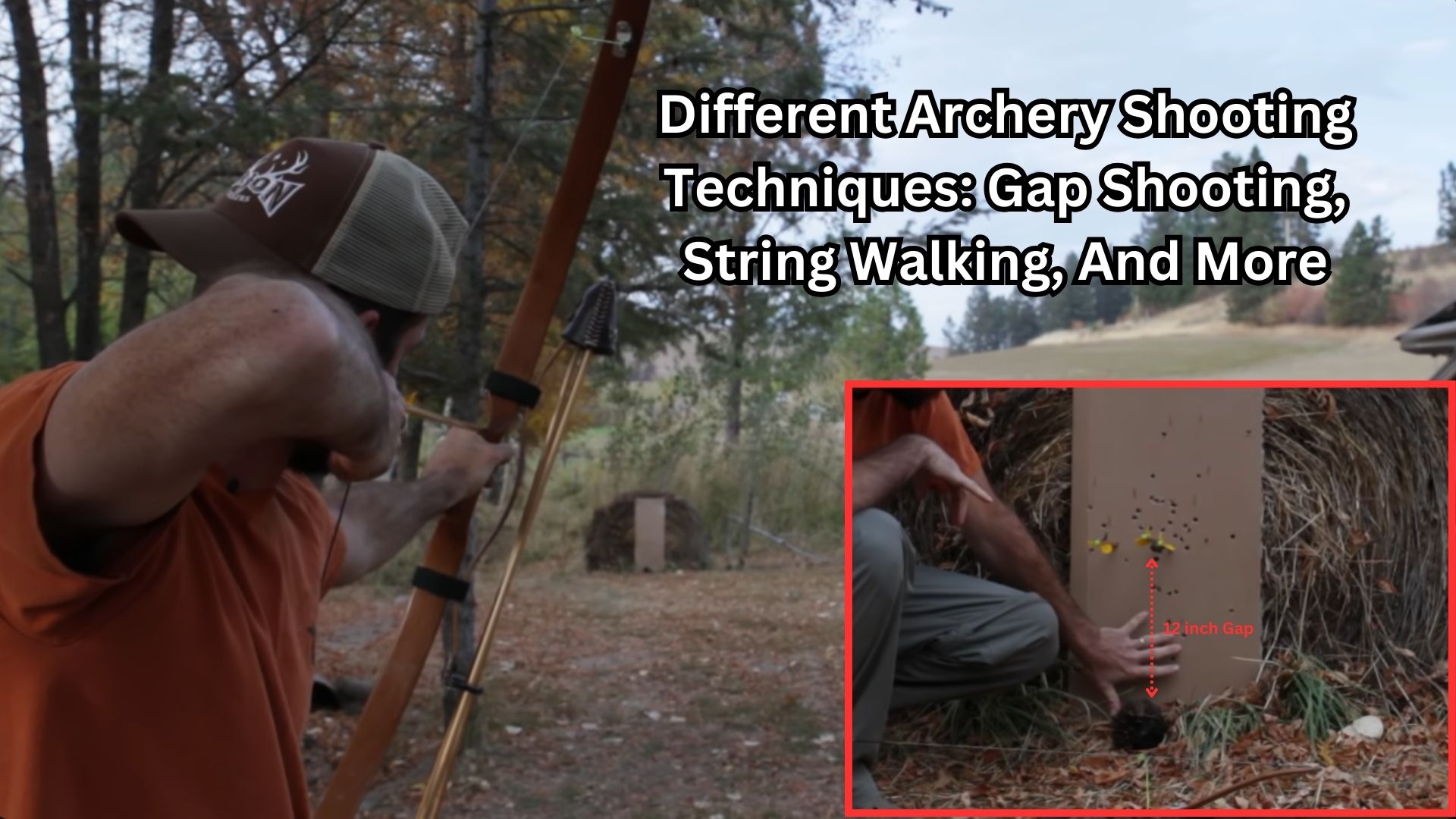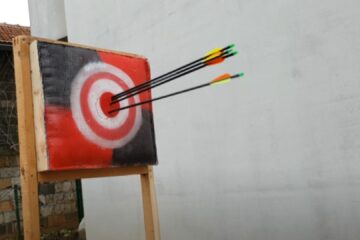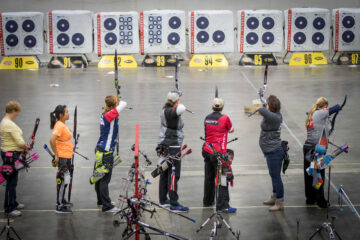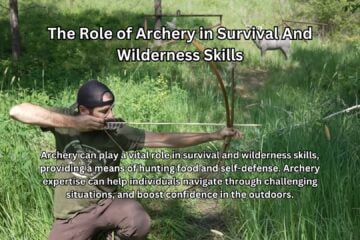Gap shooting and string walking are two different aiming techniques used in archery. In archery, there are two popular aiming techniques – gap shooting and string walking.
Gap shooting involves visually estimating the gap between the arrow tip and the target, while string walking involves using a predetermined index point on the bowstring to adjust the arrow’s trajectory. Both techniques have their pros and cons and are used by archers based on personal preference, shooting style, and competition requirements.
Understanding the differences between these two techniques can help archers choose the most effective aiming method for their needs. We will delve deeper into the concepts of gap shooting and string walking, exploring their advantages and disadvantages, and how they are utilized in the world of archery.
Gap Shooting: A Traditional Archery Technique
Definition and basic concept of gap shooting:
Gap shooting is a traditional archery technique that involves aiming at a target by visually gauging the distance between the target and the arrow tip. Unlike other aiming methods, such as string walking or using a sight, gap shooting relies on the archer’s judgment and estimation skills. The basic concept is to establish a mental reference point, or “gap,” between the target and the arrow, and adjust the bow aim accordingly.
Historical significance and common usage:
Gap shooting has deep historical significance and has been widely used by archers throughout the ages. In fact, it is one of the oldest and most traditional aiming techniques in the realm of archery. From ancient civilizations to modern-day archers, gap shooting has stood the test of time and remains a preferred technique for many traditional archery enthusiasts.
Benefits of gap shooting in precision archery:
Gap shooting offers several benefits, particularly in the realm of precision archery:
- Accuracy: Gap shooting allows archers to quickly adapt to varying distances without the need for using complex tools or relying on external aids. This enables them to make more accurate shots, especially in fast-paced scenarios where time is of the essence.
- Flexibility: The beauty of gap shooting lies in its adaptability. It can be used with different types of bows and arrows, making it a versatile technique that can be utilized in various archery styles and disciplines.
- Connection with traditional archery: For those who are passionate about traditional archery, gap shooting provides a connection to the roots of this ancient practice. It allows archers to experience the same techniques and methods that were used by bowmen of centuries past.
Challenges and limitations of gap shooting:
While gap shooting has its merits, it also presents some challenges and limitations that archers need to be aware of:
- Practice and experience: Mastering the art of gap shooting requires time, practice, and experience. It involves developing a keen sense of judgment and a deep understanding of individual shooting styles and arrow trajectories.
- Varied target distances: Gap shooting becomes more challenging when dealing with targets at different distances. As the gap between the target and arrow changes, the archer must make adjustments, which can impact accuracy and consistency.
- Vision and focus: Good eyesight and focus are crucial for successful gap shooting. Archers must be able to accurately gauge the gap and maintain focus on both the target and the arrow simultaneously.
Tips and techniques for mastering gap shooting:
Here are some tips and techniques to help archers improve their gap shooting skills:
- Consistent anchor point: Establishing a consistent anchor point is important as it serves as a reference for determining gap size.
- Target practice: Regular practice on targets of different sizes and distances will help archers develop a better understanding of their gaps and improve accuracy.
- Experiment with distances: To expand your shooting skillset, practice shooting at various known and unknown distances to develop a more intuitive sense of gap estimation.
- Mental visualization: Visualize the gap between the target and arrow, creating a mental image and focusing on aligning the arrow tip with the intended impact point.
- Adjustments and refinements: Continually refine and adjust your shooting technique, paying attention to the consistency of your anchor point and the accuracy of your gap estimation.
By practicing these tips and techniques, archers can enhance their gap shooting abilities and achieve greater precision and consistency in their archery endeavors.
String Walking: An Alternative Approach
When it comes to precision archery, there are various aiming methods to consider. One such approach is string walking, which offers archers a unique way to aim and shoot accurately. In this article, we will explore string walking as an alternative approach to archery and delve into its definition, evolution, advantages, and disadvantages, as well as tips and techniques for mastering this method.
Definition and Basic Concept of String Walking
String walking is an aiming technique in archery where the archer adjusts the position of their anchor point along the bowstring, thereby altering the angle of their arrow’s trajectory. Unlike traditional gap shooting, which involves estimating the distance to the target and aiming using predetermined gaps, string walking offers a more dynamic approach. By changing the position of their anchor point, archers can adjust their aim for each individual shot, allowing for precise aiming at varying distances.
Evolution of String Walking in Modern Archery
String walking has seen increased popularity in recent years, as archers have discovered its effectiveness in precision shooting. Originally utilized as a technique for hunting in thick vegetation, string walking has now evolved into a specialized method for target shooting. Modern archers have refined the technique, incorporating it into their training and competitions to achieve exceptional accuracy.
Advantages and Disadvantages of String Walking in Precision Archery
Like any aiming method, string walking has its own set of advantages and disadvantages. One significant advantage is the ability to adjust aim for each shot, regardless of distance. This flexibility allows archers to adapt to various environmental factors and differing target distances more effectively. Additionally, string walking can enhance consistency in shooting form, as the anchor point remains consistent across different distances.
On the other hand, one disadvantage of string walking is that it requires a solid grasp of distance judgment. Unlike gap shooting, where predetermined gaps are used as reference points, archers using string walking must accurately estimate the distance to their target for each shot. This can be challenging, especially for beginners or archers transitioning from other aiming methods. Furthermore, string walking may require additional practice and skill development to master.
Tips and Techniques for Developing String Walking Skills
To become proficient in string walking, archers can follow some helpful tips and techniques. Here are a few key points to consider:
- Start with close-range shots: Begin by practicing string walking at shorter distances, gradually increasing the range as skills improve.
- Focus on distance estimation: Enhance distance judgment abilities by practicing estimating the distance to targets without relying on predetermined gaps.
- Experiment with anchor point positions: Adjust the anchor point along the bowstring to find the most effective aiming position for each distance.
- Aim for consistency: Maintain a consistent anchor point and follow through to ensure consistent results.
- Seek guidance: Consider seeking guidance from experienced archers or coaches who can provide valuable insights and tips on improving string walking skills.
Comparing String Walking to Other Aiming Methods
String walking offers a distinctive approach to aiming in archery, distinguishing it from other methods such as gap shooting or instinctive shooting. While gap shooting requires estimating gaps between the arrow and the target based on distance, string walking focuses on altering the anchor point to adjust the arrow’s trajectory. Both methods have their merits, and each archer must decide which approach suits their style and goals.
In conclusion, string walking provides an alternative approach to precision archery, allowing archers to adjust their aim for each shot by altering the position of their anchor point. This technique requires practice and distance judgment, but it offers flexibility and consistency in aiming. By following the tips and techniques outlined, archers can develop their string walking skills and incorporate this unique method into their archery repertoire.
Factors To Consider
Understanding your shooting style and preferences
Before deciding whether to use gap shooting or string walking, it’s important to have a clear understanding of your shooting style and preferences. Gap shooting involves using a fixed point of aim above or below the target, while string walking involves adjusting the position of your fingers along the string to change the aiming point. Both methods have their advantages and disadvantages, so it’s crucial to choose the one that aligns with your shooting style and feels most comfortable.
Analyzing your equipment and bow setup
The equipment you use and the setup of your bow can also play a role in determining which method is best for you. Factors such as your bow’s draw weight, arrow rest, and sight setup can affect the trajectory of your arrows. Analyzing these aspects will help you determine whether your equipment is better suited for gap shooting or string walking. It’s important to ensure that your equipment is optimized for the method you choose to maximize your accuracy and shooting performance.
Evaluating your shooting environment and distance
The shooting environment and distance at which you typically shoot arrows should also be taken into consideration. Gap shooting usually works best when shooting at fixed distances or in environments where you have clear reference points to determine the gap. On the other hand, string walking allows for more flexibility when shooting at varying distances or in environments where reference points may not be available. Evaluating your shooting environment and considering the distances you commonly shoot at will help you decide which method is more suitable for your needs.
Considering your skill level and experience
Another important factor to consider is your skill level and experience in archery. Gap shooting requires a good understanding of arrow trajectory and a high level of shooting consistency. If you are a beginner or still developing your archery skills, string walking may be a more forgiving option as it allows for easier adjustments to ensure accurate aiming. However, if you have extensive experience and feel confident in your shooting abilities, gap shooting can provide more precision and control over your shots.
Seeking guidance from a professional instructor
Regardless of your shooting style or preferences, it’s always beneficial to seek guidance from a professional archery instructor. They can provide personalized advice and help you determine the best method based on your individual needs and goals. A professional instructor can also assist you in fine-tuning your techniques and form to maximize your shooting performance. Don’t hesitate to consult with an expert to ensure you’re making informed decisions and progressing in your archery journey.
Experimentation And Practice
When it comes to traditional archery, there are two popular techniques that archers often debate – gap shooting and string walking. Both techniques have their own advantages and require a certain level of skill and precision. Experimentation and practice play a crucial role in finding the right technique and refining your skills. Let’s take a closer look at the importance of trial and error, incorporating both techniques into your training routine, setting up a practice regimen, and analyzing and adjusting your aim to ensure accuracy.
Importance of trial and error in finding the right technique
Trial and error is an essential part of discovering the best shooting technique for you. Every archer is unique, and factors such as draw length, anchor point, and sight picture can vary from person to person. By experimenting with both gap shooting and string walking techniques, you can determine which one feels more comfortable and suits your shooting style.
Incorporating both gap shooting and string walking into your training routine
Incorporating both techniques into your training routine can provide a well-rounded skill set. Gap shooting relies on estimating the distance between you and the target, while string walking involves using reference points along the string to determine the desired arrow trajectory. By practicing both methods, you can adapt to different shooting scenarios and become a more versatile archer.
Setting up a practice regimen to refine your skills
A structured practice regimen is essential for refining your skills in both gap shooting and string walking. Start by dedicating specific practice sessions for each technique. During gap shooting sessions, focus on estimating distances accurately and developing muscle memory for consistent anchor points. In string walking sessions, concentrate on finding the optimal reference points on the string and adjusting your aim accordingly.
It’s also crucial to incorporate target variations into your practice routine. Experiment with different distances, angles, and target sizes to simulate real shooting scenarios. By challenging yourself with diverse targets, you can improve your ability to adapt and make accurate shots in various situations.
Analyzing and adjusting your aim based on feedback and results
Regularly analyze your aim and adjust based on feedback and results. Pay close attention to your arrow grouping and consistency. Are your arrows consistently hitting above or below the target? Do you notice any patterns? Adjusting your anchor points or reference points on the string can help rectify any inconsistencies and improve your aim.
Keep in mind that practice and experimentation go hand in hand. As you continue to refine your technique and skill, don’t be afraid to make adjustments and try different strategies. Remember, finding the right technique is a personal journey, and what works for one archer may not work for another. Ultimately, it’s the combination of experimentation, practice, and perseverance that will lead you to become a skilled archer proficient in both gap shooting and string walking techniques.
Proper Form And Technique
Proper Form and Technique
When it comes to traditional archery, whether you practice gap shooting or string walking, having proper form and technique is crucial for consistent and accurate shooting. In this section, we will explore the key elements of establishing a consistent anchor point, perfecting your grip and hand position, maintaining proper body alignment and posture, understanding the role of breathing and relaxation, and incorporating follow-through for enhanced accuracy.
Establishing a consistent anchor point
The anchor point is the spot where you draw the string back to every time you take a shot. It provides stability and consistency, ensuring that your aim and release remain the same. To establish a consistent anchor point, follow these steps:
- Start by placing the knuckle of your index finger against the corner of your mouth.
- Position your thumb on your jawbone, just below your ear.
- Lightly touch the string to the tip of your nose.
Practicing this anchor point consistently will help you achieve greater accuracy and repeatability in your shots.
Perfecting your grip and hand position
Your grip and hand position play a crucial role in maintaining control and stability while shooting. Here are some guidelines to perfect your grip:
- Place the bow grip at the base of your thumb, allowing the lifeline of your hand to rest against the grip.
- Wrap your fingers around the grip, maintaining a relaxed and firm hold.
The key is to find a grip that feels comfortable and allows you to have a strong connection with your bow, enabling smooth and consistent shots.
Maintaining proper body alignment and posture
A proper body alignment and posture are essential for consistent shooting and minimizing physical strain. Follow these guidelines:
- Stand with your feet shoulder-width apart, perpendicular to your target.
- Keep your back straight and your shoulders relaxed.
- Align your hips, shoulders, and shooting arm, ensuring everything is in line with the target.
By maintaining good body alignment and posture, you will have better control over your shots and reduce the risk of muscle fatigue or injury.
Understanding the role of breathing and relaxation
Breathing and relaxation are often overlooked in archery, but they are vital for steady aiming and a smooth release. Practice the following techniques:
- Take a deep breath in as you draw the string back, filling your lungs completely.
- Hold your breath for a brief moment while aiming.
- Exhale slowly and smoothly as you release the string, allowing your body to relax.
Remember that a relaxed body and mind lead to better focus and precision.
Incorporating follow-through for enhanced accuracy
Follow-through is the process of maintaining your shooting position and focus after releasing the string. It is crucial for consistent and accurate results. Follow these steps:
- Keep your bow hand stationary and extend it towards the target.
- Remain focused on the target even after the arrow has been released.
- Hold your shooting position until the arrow hits the target.
Incorporating follow-through into your shooting routine will help improve your accuracy by minimizing any negative effects caused by abrupt movements or loss of focus.
By mastering these proper form and technique elements, you will enhance your shooting skills, regardless of whether you prefer gap shooting or string walking. Remember to practice consistently and seek guidance from experienced archers to further refine your technique.
Mental Focus And Concentration
When it comes to precision archery, mental focus and concentration play a crucial role in achieving accurate shots. It is not just about physical technique, but also about developing a strong mental attitude. Archers need to manage distractions, control nerves, utilize visualization techniques, set goals, and maintain motivation throughout the process. By incorporating mindfulness and meditation into their archery practice, archers can enhance their focus and concentration, improving their overall performance. In this article, we will explore the various strategies and practices to develop a strong mental attitude for precision archery.
Developing a strong mental attitude for precision archery
Archery requires more than just physical strength and accuracy. It demands a strong mental attitude that enables archers to stay focused and composed. Here are some strategies to cultivate a strong mental attitude:
Managing distractions and controlling nerves
Distractions can hinder an archer’s focus and concentration. To maintain mental toughness, archers need to learn how to manage distractions effectively. Here’s how to do it:
- Acknowledge and accept distractions.
- Develop a pre-shot routine to refocus the mind.
- Practice relaxation techniques to control nerves.
- Focus on the present moment and block out external factors.
Utilizing visualization techniques to improve aim
Visualization can be a powerful tool to enhance aim and accuracy in archery. By mentally rehearsing the shot, archers can improve their muscle memory and increase their chances of hitting the target. Try the following visualization techniques:
- Close your eyes and vividly imagine the perfect shot.
- Visualize the arrow’s trajectory, hitting the bullseye.
- Feel the release, the bowstring against your fingers.
- Repeat this visualization exercise before each shot.
Setting goals and maintaining motivation throughout the process
Setting achievable goals is essential for archers to stay motivated and focused. Here’s how to set goals effectively:
- Set specific, measurable, attainable, relevant, and time-bound (SMART) goals.
- Break down larger goals into smaller, manageable steps.
- Celebrate small victories along the way.
- Stay motivated by reminding yourself of the bigger picture and the reasons why you took up archery.
Incorporating mindfulness and meditation in archery practice
Mindfulness and meditation can greatly enhance an archer’s focus, concentration, and overall mental well-being. Try incorporating the following practices into your archery routine:
- Practice deep breathing exercises before and during archery sessions.
- Observe your thoughts and emotions without judgment.
- Cultivate present-moment awareness during each shot.
- Consider incorporating formal meditation practices into your daily routine to train your mind to stay calm and focused.
Equipment And Gear Considerations
Choosing the right equipment and gear is crucial for both gap shooting and string walking techniques. From selecting the right bow and arrow setup to understanding the impact of arrow spine and weight on aim, each element plays a vital role in optimizing your shooting experience. In this section, we will explore the various aspects to consider when it comes to equipment and gear for both techniques.
Choosing the right bow and arrow setup for your technique:
When it comes to choosing the right bow and arrow setup, several factors need to be taken into account. Both gap shooting and string walking require bows with specific characteristics to enhance accuracy and precision.
- Bow type: For gap shooting, a recurve or longbow is commonly used, as they offer better trajectory control. On the other hand, a compound bow is often favored for string walking due to its adjustable draw length and let-off.
- Draw weight: The draw weight of your bow should match your ability to handle it comfortably. It is important to find a balance between power and control to execute your shooting technique effectively.
- Arrow rest: Gap shooters often opt for a simple rug-style rest to allow for more arrow clearance and improved arrow flight. String walkers, on the other hand, typically prefer a more secure and adjustable drop-away rest for consistent arrow positioning.
Understanding the impact of arrow spine and weight on aim:
Both arrow spine and weight play a crucial role in your shooting accuracy and aim. The spine of an arrow refers to its flexibility, and choosing the right spine is essential for consistent and precise shooting. The weight of your arrows also affects your aim, as heavier arrows tend to be less affected by wind and offer better downrange energy.
| Impact of Arrow Spine | Impact of Arrow Weight |
| Choose a stiffer arrow spine for gap shooting to compensate for the fixed reference point and varying distances. | Consider heavier arrows for both techniques to minimize the impact of wind and maintain better downrange energy. |
| A more flexible arrow spine is suitable for string walking, as it allows for better compensation of the varying draw lengths. | Lighter arrows can be advantageous for string walking due to the reduced strain on the bow and improved arrow trajectory. |
Exploring different sight options for gap shooting and string walking:
Sight options can greatly impact your shooting technique, and it is important to select the one that aligns with your preferred method. Let’s take a look at the sight options for both gap shooting and string walking:
- For gap shooting, traditional fixed pin sights or instinctive shooting without a sight are commonly used to estimate the distance and execute accurate shots.
- String walking technique often benefits from the use of adjustable single-pin sights or movable sight systems. These allow for precise elevation adjustments when the draw length varies.
Adjusting equipment for varying shooting distances and conditions:
As a gap shooter or string walker, it is essential to be prepared for shooting in various distances and conditions. Consider the following aspects while adjusting your equipment:
- Bow sight adjustments: Depending on the distance, you may need to adjust your bow sight for vertical alignment. Experimenting with different offsets can help you find the right point of aim.
- Arrow selection: For longer distances, lighter arrows with a flatter trajectory are often preferred. On the other hand, heavier arrows may be beneficial in windy conditions to maintain stability.
- Weather considerations: Changes in weather conditions such as temperature and humidity can impact the flex of your arrows. Regularly check and adjust your equipment accordingly to maintain optimal shooting performance.
Regular maintenance and tuning for optimal performance:
To ensure consistent and optimal performance, regular maintenance and tuning of your equipment are necessary. Pay attention to the following areas:
- Bowstring and cables: Regularly inspect your bowstring and cables for signs of wear and replace them when necessary. Properly wax and condition your bowstring to maintain optimal performance.
- Arrow rest and sight alignment: Periodically check the alignment of your arrow rest and sight to ensure they are properly positioned. Any misalignment can significantly impact your shooting accuracy.
- Bow limb and riser: Inspect your bow’s limbs and riser for any cracks or damage. Keeping them in good condition is essential for consistent shooting performance.
By selecting the right equipment, considering arrow spine and weight, exploring different sight options, adjusting for varying shooting distances and conditions, and performing regular maintenance, you can optimize your shooting performance and enjoy a rewarding experience with either gap shooting or string walking.
Frequently Asked Questions Of Gap Shooting Vs String Walking
Is String Walking The Same As Gap Shooting?
No, string walking and gap shooting are not the same. They are two different techniques used in archery.
What Is The Difference Between Gap Shooting And Instinctive Archery?
Gap shooting and instinctive archery are different techniques used in archery. Gap shooting involves visually judging the distance between the archer and target, while instinctive archery relies on muscle memory and instinct to aim and shoot. Both techniques require practice and skill to master.
What Is String Walking?
String walking is a technique used in archery where archers adjust their anchor point by moving their finger position on the string. It helps to compensate for varying distances to the target, allowing for more accurate shots.
What Does Gap Shooting Mean In Archery?
Gap shooting in archery refers to a shooting technique where the archer estimates the distance to the target and aims by visually aligning the arrow tip with the target. This method requires practice to accurately judge the gap between the arrow tip and the target at different distances.
Conclusion
Gap shooting and string walking are two popular techniques in archery that offer distinct advantages. Gap shooting allows archers to estimate distances and adjust their aim accordingly, while string walking involves using the arrow tip as a reference point for aiming.
Both techniques have their merits and it ultimately comes down to personal preference and shooting style. Whether you prefer the precision of gap shooting or the versatility of string walking, mastering either method takes practice and dedication. So, choose the technique that best suits your style and keep honing your skills to become a true archery expert.
Happy shooting!







